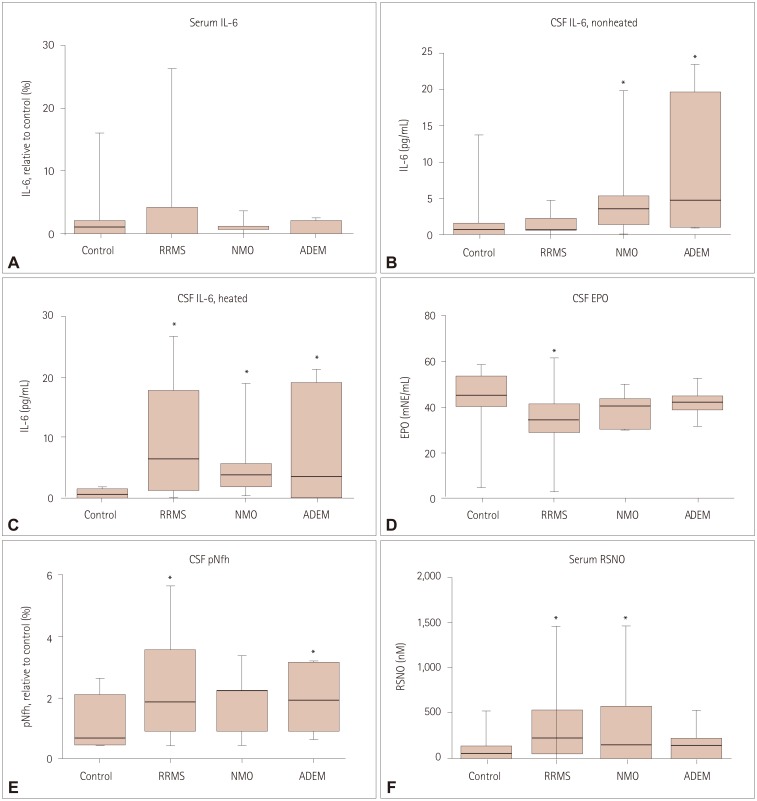1. Kallaur AP, Reiche EM, Oliveira SR, Simão AN, Pereira WL, Alfieri DF, et al. Genetic, immune-inflammatory, and oxidative stress biomarkers as predictors for disability and disease progression in multiple sclerosis. Mol Neurobiol. 2017; 54:31–44. PMID:
26732588.

2. Janssens K, Slaets H, Hellings N. Immunomodulatory properties of the IL-6 cytokine family in multiple sclerosis. Ann N Y Acad Sci. 2015; 1351:52–60. PMID:
26100315.

3. Matsushita T, Tateishi T, Isobe N, Yonekawa T, Yamasaki R, Matsuse D, et al. Characteristic cerebrospinal fluid cytokine/chemokine profiles in neuromyelitis optica, relapsing remitting or primary progressive multiple sclerosis. PLoS One. 2013; 8:e61835. PMID:
23637915.

4. Uzawa A, Mori M, Uchida T, Masuda H, Ohtani R, Kuwabara S. Seronegative neuromyelitis optica spectrum disorder patients diagnosed using new diagnostic criteria. Mult Scler. 2016; 22:1371–1375. PMID:
26552730.

5. Chang KH, Ro LS, Lyu RK, Chen CM. Biomarkers for neuromyelitis optica. Clin Chim Acta. 2015; 440:64–71. PMID:
25444748.

6. Chihara N, Aranami T, Sato W, Miyazaki Y, Miyake S, Okamoto T, et al. Interleukin 6 signaling promotes anti-aquaporin 4 autoantibody production from plasmablasts in neuromyelitis optica. Proc Natl Acad Sci U S A. 2011; 108:3701–3706. PMID:
21321193.

7. Wullschleger A, Kapina V, Molnarfi N, Courvoisier DS, Seebach JD, Santiago-Raber ML, et al. Cerebrospinal fluid interleukin-6 in central nervous system inflammatory diseases. PLoS One. 2013; 8:e72399. PMID:
24015240.

8. Uzawa A, Mori M, Masuda H, Ohtani R, Uchida T, Sawai S, et al. Interleukin-6 analysis of 572 consecutive CSF samples from neurological disorders: a special focus on neuromyelitis optica. Clin Chim Acta. 2017; 469:144–149. PMID:
28283439.

9. Araki M, Matsuoka T, Miyamoto K, Kusunoki S, Okamoto T, Murata M, et al. Efficacy of the anti-IL-6 receptor antibody tocilizumab in neuromyelitis optica: a pilot study. Neurology. 2014; 82:1302–1306. PMID:
24634453.

10. Beauchemin P, Carruthers R. MS arising during Tocilizumab therapy for rheumatoid arthritis. Mult Scler. 2016; 22:254–256. PMID:
26743640.

11. Kleiter I, Ayzenberg I, Araki M, Yamamura T, Gold R. Tocilizumab, MS, and NMOSD. Mult Scler. 2016; 22:1891–1892. PMID:
27068554.

12. Krumbholz M, Meinl E. B cells in MS and NMO: pathogenesis and therapy. Semin Immunopathol. 2014; 36:339–350. PMID:
24832354.

13. Kaplin AI, Deshpande DM, Scott E, Krishnan C, Carmen JS, Shats I, et al. IL-6 induces regionally selective spinal cord injury in patients with the neuroinflammatory disorder transverse myelitis. J Clin Invest. 2005; 115:2731–2741. PMID:
16184194.

14. Fominykh V, Onufriev MV, Vorobyeva A, Brylev L, Yakovlev AA, Zakharova MN, et al. Increased S-nitrosothiols are associated with spinal cord injury in multiple sclerosis. J Clin Neurosci. 2016; 28:38–42. PMID:
26778356.

15. Polman CH, Reingold SC, Banwell B, Clanet M, Cohen JA, Filippi M, et al. Diagnostic criteria for multiple sclerosis: 2010 revisions to the McDonald criteria. Ann Neurol. 2011; 69:292–302. PMID:
21387374.

16. Thompson AJ, Banwell BL, Barkhof F, Carroll WM, Coetzee T, Comi G, et al. Diagnosis of multiple sclerosis: 2017 revisions of the Mc-Donald criteria. Lancet Neurol. 2018; 17:162–173. PMID:
29275977.

17. Krupp LB, Tardieu M, Amato MP, Banwell B, Chitnis T, Dale RC, et al. International Pediatric Multiple Sclerosis Study Group criteria for pediatric multiple sclerosis and immune-mediated central nervous system demyelinating disorders: revisions to the 2007 definitions. Mult Scler. 2013; 19:1261–1267. PMID:
23572237.

18. Brownlee WJ, Hardy TA, Fazekas F, Miller DH. Diagnosis of multiple sclerosis: progress and challenges. Lancet. 2017; 389:1336–1346. PMID:
27889190.

19. Wingerchuk DM, Banwell B, Bennett JL, Cabre P, Carroll W, Chitnis T, et al. International consensus diagnostic criteria for neuromyelitis optica spectrum disorders. Neurology. 2015; 85:177–189. PMID:
26092914.

20. Brailly H, Montero-Julian FA, Zuber CE, Flavetta S, Grassi J, Houssiau F, et al. Total interleukin-6 in plasma measured by immunoassay. Clin Chem. 1994; 40:116–123. PMID:
8287518.

21. Wink DA, Kim S, Miles A, Jourd'heuil D, Grisham MB. Fluorometric techniques for the detection of nitric oxide and metabolites. Curr Protoc Toxicol. 2001; 10:4. PMID:
23045026.

22. Michalopoulou M, Nikolaou C, Tavernarakis A, Alexandri NM, Rentzos M, Chatzipanagiotou S, et al. Soluble interleukin-6 receptor (sIL-6R) in cerebrospinal fluid of patients with inflammatory and non inflammatory neurological diseases. Immunol Lett. 2004; 94:183–189. PMID:
15275965.

23. Padberg F, Feneberg W, Schmidt S, Schwarz MJ, Körschenhausen D, Greenberg BD, et al. CSF and serum levels of soluble interleukin-6 receptors (sIL-6R and sgp130), but not of interleukin-6 are altered in multiple sclerosis. J Neuroimmunol. 1999; 99:218–223. PMID:
10505978.
24. Stelmasiak Z, Kozioł-Montewka M, Dobosz B, Rejdak K. IL-6 and sIL-6R concentration in the cerebrospinal fluid and serum of MS patients. Med Sci Monit. 2001; 7:914–918. PMID:
11535934.
25. Wang H, Wang K, Zhong X, Dai Y, Qiu W, Wu A, et al. Notable increased cerebrospinal fluid levels of soluble interleukin-6 receptors in neuromyelitis optica. Neuroimmunomodulation. 2012; 19:304–308. PMID:
22777162.

26. Barros PO, Cassano T, Hygino J, Ferreira TB, Centurião N, Kasahara TM, et al. Prediction of disease severity in neuromyelitis optica by the levels of interleukin (IL)-6 produced during remission phase. Clin Exp Immunol. 2016; 183:480–489. PMID:
26472479.

27. Bonnan M, Marasescu R, Demasles S, Krim E, Barroso B. No evidence of disease activity (NEDA) in MS should include CSF biology - towards a ‘Disease-Free StatusScore’. Mult Scler Relat Disord. 2017; 11:51–55. PMID:
28104257.
28. Takano R, Misu T, Takahashi T, Sato S, Fujihara K, Itoyama Y. Astrocytic damage is far more severe than demyelination in NMO: a clinical CSF biomarker study. Neurology. 2010; 75:208–216. PMID:
20644148.

29. Kempuraj D, Thangavel R, Natteru PA, Selvakumar GP, Saeed D, Zahoor H, et al. Neuroinflammation induces neurodegeneration. J Neurol Neurosurg Spine. 2016; 1:1003. PMID:
28127589.






 PDF
PDF ePub
ePub Citation
Citation Print
Print


 XML Download
XML Download